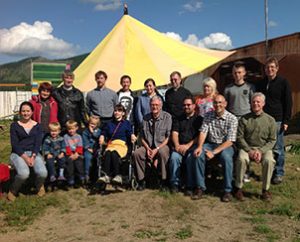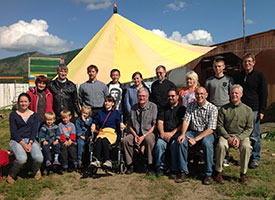By Joe Isenhower Jr.
Three LCMS leaders went to camp this summer in Siberia.
Within a month after the 2013 LCMS convention affirmed fellowship with the Siberian Evangelical Lutheran Church (SELC), the Rev. Drs. Albert B. Collver III and Timothy Quill, along with the Rev. Randall Golter, made presentations in the vast region of that Russian church body to SELC pastors, lay members and their unchurched guests at several summer seminars in camp-like settings.

Their trip to Russia was Aug. 12-24. During that time, they also toured the SELC’s Lutheran Theological Seminary in Novosibirsk, witnessed Siberian pastors leading worship (including during home visits) and the devotion of lay members. They also conducted in-depth discussions with the Rev. Alexey Streltsov, the Siberian seminary’s rector, about possible future plans for theological education and expanding Gospel work in Russia and other parts of Central Asia.
The first of the three seminars was at St. Mary’s Lutheran Church in Tomsk, where Collver gave a presentation on “World Lutheranism — with emphasis on Ethiopia, Tanzania and Madagascar.” Accompanying him there was Golter, who is executive director of the LCMS Office of International Mission.
Collver, who is director of Church Relations for the Synod, told Reporter that St. Mary’s is a congregation whose church building was demolished and its pastor killed in 1937 during the communist purge of organized religion. The Soviet government then built an amusement park on the site of the church’s property. A Ferris wheel that Siberian Lutherans now refer to as “the devil’s wheel” stands where the church’s altar was located; and its base was reportedly built with material from the destroyed altar. The current church of St. Mary’s — built in the early 2000s as the congregation formed once again — sits on property near the amusement park.
The second seminar for the LCMS leaders was at a former Soviet Union-operated sanitarium in Angarsk (near Lake Baikal), and the third was at the SELC’s “Camp Between the Rivers” near the village of Efremkino. The two rivers are the White Ius and Black Ius, both of which Collver described in a “Witness, Mercy, Life Together” blog post as “beautiful and considered to have pure water.”
Collver, whose trip to Siberia this summer was his eighth, also gave presentations on “The Gospel of Mark: theology of the cross” for the second and third seminars .
Quill is LCMS director for Global Seminary Education, as well as associate professor of Pastoral Ministry and Missions and dean of International Studies at Concordia Theological Seminary (CTS), Fort Wayne, Ind. He has been to Siberia a number of times. In fact, he helped Siberian Lutherans organize their first summer seminars 16 years ago and recalls that those earlier years’ lectures were all given by visiting LCMS professors and pastors. In addition, Quill was instrumental in working on behalf of the Synod with Siberian Lutherans to establish the seminary in Novosibirsk in 1997, when he also was director of the CTS Russian Project.
He told Reporter that the SELC holds the seminars “as part of their mission outreach and catechetical work to deepen the Lutheran understanding among laity.” Quill’s seminar topic was “The presence of Christ in the liturgy and sermon.”
In the time since the SELC seminary was registered with the state in 2003 and received the state license for higher theological education in 2009, “dozens of students have gone through its programs,” according to Streltsov, who pointed out that “the summer seminars of the SELC in a way preceded the seminary itself,” with the first seminar held in the summer of 1996.
“One of the most rewarding aspects [of the seminars] is to observe the dedicated Russian pastors who have graduated from the seminary in Novosibirsk,” Quill said. “They combine a mature theological understanding developed from their rigorous years of residential studies … with a commitment to pastoral care.”
“Over the years,” Quill added, “as more and more Russian men have completed their studies under LCMS professors, they have picked up more … of the responsibility as summer seminar teachers. The obvious advantage is that they do not require translators and know the cultural nuances.”
While Quill, Collver and Golter participated in the three summer seminars, Streltsov served as their translator.
Quill said that during evening question-and-answer periods, seminar “conversation went quickly beyond the biblical and theological issues from the daytime lectures to personal questions about how Americans view Russians or to a discussion of the challenges of being a faithful Lutheran today in Russia and America.”
“For the seminary,” Streltsov told Reporter via email, “summer seminars serve as a means to both provide summer practicum opportunities for its students as well as [a] place to locate new prospective students.” He indicated that as many as six seminars are held each year, and that topics such as those presented by Collver, Quill and Golter “take confessional understanding of our people still further.”
For example, Streltsov recalled that at one of this year’s seminars, “[an] older lady from a very remote and poor parish properly reacted to a quasi-Pentecostal song that was presented by one of the guests. ‘This is not part of our church culture, it is not compatible with our confession,’ she said.
“I was amazed how well prepared she was to discern the theological accents in the songs,” Streltsov wrote.
This was the first trip to Siberia for Golter, who joined the LCMS Office of International Mission earlier this year, after serving as president of the LCMS Rocky Mountain District.
Streltzov initially invited Collver and Quill to lecture for this summer’s seminars. Collver said that he and Quill “thought that it would be good for [Golter] to attend and see first-hand how the SELC conducts itself.”
“What struck me during the seminars,” Golter said, “was that pastors and lay people sat there with rapt enthusiasm. They listened closely and asked very good questions.” His seminar presentations were titled “The Church in mission — from the beginning” and “The Church in mission — the speaking God.”
Streltsov wrote in his email to Reporter that “our people benefited a lot” from the presentations of the three Synod leaders, who “are closely involved in the global work of the LCMS today, so it is always interesting to hear what they have to say. Besides, they managed to retain their theological expertise and pastoral attitude despite their bureaucratic engagements — a rarity nowadays.”
He added that several seminar participants told him that they “really liked the lectures” by the LCMS leaders.
“I see the major impact of such seminars in increased awareness of their participants of the treasures contained in the Holy Scriptures and Lutheran Confessions,” Streltsov wrote. “Seminar materials will enable them to stay focused in the heterodox or non-Christian hostile environment in which they find themselves.”
The LCMS leaders began their Siberian visit in Novosibirsk, after a several-hour plane ride from Moscow. Streltsov then led them on the tour of the seminary.
Golter was “particularly impressed” with the seminary’s location in Novosibirsk, which has a population of about two million — “a major metropolitan area which during the communist era was the scientific center of the Soviet Union,” he said. “It is crucial for confessional Lutherans to have a seminary there, in the midst of such an academic and scientific setting,” he continued, adding that some 35 research institutes are located in that city.
Novosibirsk served as a base for the group as they traveled within a 200-mile radius of there for the seminars and to congregations and other sites where they met with pastors and lay people.
Golter said that the time in Siberia this summer did indeed help him “understand the context of the SELC and how we can work together with that church with whom we are in fellowship — for their being church and our being church — to help preach the Gospel in that region of the world.”
Collver echoed Golter’s commitment for the Synod and the SELC to work together in Gospel outreach, adding that such “joint work in Central Asia” would be helped with the Siberian church’s current work among “several ethnic groups” that are already represented within its membership.
Currently, the SELC consists of approximately 21 congregations and 21 pastors and deacons across Siberia, which covers the largest land area of any LCMS partner church.
Golter pointed out that in 1918, Lutheran membership in Russia numbered more than a million, but was then decimated over the next 70 years of communist control.
He also noted that the history of Lutheranism in Russia preceded the LCMS, since it existed there in the 16th century soon after the Reformation.
Golter concluded that in Siberia, it is “a wonderful thing to see pastors and laypeople being faithful Lutherans … where God has placed them, despite the challenges of revitalizing a church that was almost extinguished. The challenges are great, but God is faithful. And this church wants to be faithful to Lutheran doctrine and practice.”
Updated September 7, 2013
